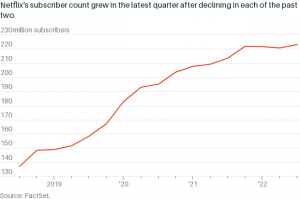Netflix Stock Soars as Subscriber Growth Tops Expectations
Netflix shares were trading sharply higher after the streaming giant posted better-than-expected subscriber growth for the third quarter.
The company added 2.41 million net new subscribers in the quarter, beating its own forecast of 1 million additions. Netflix (ticker: NFLX) said it expects to add another 4.5 million subscribers in the December quarter.
Netflix stock jumped 14% in late trading to $274.60.
The streaming company posted third-quarter revenue of $7.93 billion and earnings of $3.10 a share, ahead of the company’s forecast of $7.84 billion and $2.14 a share. For the fourth quarter, Netflix projects revenue of $7.78 billion and earnings of 36 cents a share.
Revenue in the latest quarter was up 6% but would have been 13% higher in constant currency, as the strong dollar took a considerable toll on reported results. The company said the revenue increase reflected a 5% increase in average paid memberships versus a year ago and a 1% rise in average revenue per membership.
The company said revenue was up 19% in the Asia-Pacific region adjusted for currency; 13% in the Europe, Middle East and Africa region; and 19% in Latin America. For the U.S. and Canada, revenue was up 12%, with paid subscribers up 100,000. The bigger subscriber increase was in the Asia-Pacific region, where the total increased 1.43 million. The company added 570,000 subscribers in EMEA, and 310,000 in Latin America.
Operating margin was 19.3%, falling from 23.5% a year ago and 19.8% in the June quarter, declines the company said were due to foreign exchange factors. Net income of $1.398 billion includes a $348 million noncash change tied to the company’s Euro-denominated debt.
The company expects an operating margin of 4% in the fourth quarter, down from 8% a year ago, due to both foreign exchange rates and higher content and marketing costs. Netflix said that the strong dollar will reduce full-year revenue by about $1 billion, with about an $800 million reduction in operating income.
In one surprise development, Netflix said that starting next quarter, the company would no longer give guidance on paid memberships—the metric that has been most important to investors in recent quarters. The company will still report quarterly subscriber data, just not forward-looking guidance on the metric.
The company said it would continue to provide guidance on revenue, operating income, operating margin, net income, earnings per share, and shares outstanding. Netflix said that with the addition of new revenue streams such as advertising and paid sharing, revenue growth will be a better measure of the company’s growth.
The company also provided a brief update on its strategy for reducing account sharing by people not in the same household. Netflix said that starting in early 2023, it will offer people now using borrowed passwords a way to transfer their Netflix profile into their own account. The company will also offer sharers easier ways to manage devices and to create sub-accounts to pay for family or friends.
Netflix also provided an update on its gaming service, which it launched almost a year ago. There are now 35 games on the service, the company said, and there are “encouraging signs” that gameplay leads to higher subscriber retention rates. The company said there are 55 more games in development, some based on Netflix video content.
Last week, Netflix unveiled the details of its new ad-supported subscription tier. Starting Nov. 3, the company will offer consumers the option to pay $6.99 a month for “Basic with Ads,” which will include four to five minutes of advertising per hour for streaming movies and TV shows. The new service is $3 cheaper than the company’s Basic plan, which is $9.99 a month, and a dollar a month cheaper than the new ad-supported tier on Walt Disney’s (DIS) Disney+.
Netflix said it doesn’t expect a material contribution from the new ad-supported tier in the fourth quarter, noting that it expects to grow membership in that plan “gradually over time.” Netflix added that the reaction from advertisers so far has been “extremely positive.”
Netflix also used its quarterly letter as a forum to poke at the competition, noting that its rivals together will have more than $10 billion in operating losses this year, versus a projected $5.4 billon in operating profit for Netflix. “Building a large, successful streaming business is hard,” the company said.
 Copyright 2020, Dow Jones & Company, Inc. All Rights Reserved Worldwide. LEARN MORE
Copyright 2020, Dow Jones & Company, Inc. All Rights Reserved Worldwide. LEARN MORE
This stylish family home combines a classic palette and finishes with a flexible floorplan
Just 55 minutes from Sydney, make this your creative getaway located in the majestic Hawkesbury region.
As Paris makes its final preparations for the Olympic games, its residents are busy with their own—packing their suitcases, confirming their reservations, and getting out of town.
Worried about the hordes of crowds and overall chaos the Olympics could bring, Parisians are fleeing the city in droves and inundating resort cities around the country. Hotels and holiday rentals in some of France’s most popular vacation destinations—from the French Riviera in the south to the beaches of Normandy in the north—say they are expecting massive crowds this year in advance of the Olympics. The games will run from July 26-Aug. 1.
“It’s already a major holiday season for us, and beyond that, we have the Olympics,” says Stéphane Personeni, general manager of the Lily of the Valley hotel in Saint Tropez. “People began booking early this year.”
Personeni’s hotel typically has no issues filling its rooms each summer—by May of each year, the luxury hotel typically finds itself completely booked out for the months of July and August. But this year, the 53-room hotel began filling up for summer reservations in February.
“We told our regular guests that everything—hotels, apartments, villas—are going to be hard to find this summer,” Personeni says. His neighbours around Saint Tropez say they’re similarly booked up.
As of March, the online marketplace Gens de Confiance (“Trusted People”), saw a 50% increase in reservations from Parisians seeking vacation rentals outside the capital during the Olympics.
Already, August is a popular vacation time for the French. With a minimum of five weeks of vacation mandated by law, many decide to take the entire month off, renting out villas in beachside destinations for longer periods.
But beyond the typical August travel, the Olympics are having a real impact, says Bertille Marchal, a spokesperson for Gens de Confiance.
“We’ve seen nearly three times more reservations for the dates of the Olympics than the following two weeks,” Marchal says. “The increase is definitely linked to the Olympic Games.”

Getty Images
According to the site, the most sought-out vacation destinations are Morbihan and Loire-Atlantique, a seaside region in the northwest; le Var, a coastal area within the southeast of France along the Côte d’Azur; and the island of Corsica in the Mediterranean.
Meanwhile, the Olympics haven’t necessarily been a boon to foreign tourism in the country. Many tourists who might have otherwise come to France are avoiding it this year in favour of other European capitals. In Paris, demand for stays at high-end hotels has collapsed, with bookings down 50% in July compared to last year, according to UMIH Prestige, which represents hotels charging at least €800 ($865) a night for rooms.
Earlier this year, high-end restaurants and concierges said the Olympics might even be an opportunity to score a hard-get-seat at the city’s fine dining.
In the Occitanie region in southwest France, the overall number of reservations this summer hasn’t changed much from last year, says Vincent Gare, president of the regional tourism committee there.
“But looking further at the numbers, we do see an increase in the clientele coming from the Paris region,” Gare told Le Figaro, noting that the increase in reservations has fallen directly on the dates of the Olympic games.
Michel Barré, a retiree living in Paris’s Le Marais neighbourhood, is one of those opting for the beach rather than the opening ceremony. In January, he booked a stay in Normandy for two weeks.
“Even though it’s a major European capital, Paris is still a small city—it’s a massive effort to host all of these events,” Barré says. “The Olympics are going to be a mess.”
More than anything, he just wants some calm after an event-filled summer in Paris, which just before the Olympics experienced the drama of a snap election called by Macron.
“It’s been a hectic summer here,” he says.

AFP via Getty Images
Parisians—Barré included—feel that the city, by over-catering to its tourists, is driving out many residents.
Parts of the Seine—usually one of the most popular summertime hangout spots —have been closed off for weeks as the city installs bleachers and Olympics signage. In certain neighbourhoods, residents will need to scan a QR code with police to access their own apartments. And from the Olympics to Sept. 8, Paris is nearly doubling the price of transit tickets from €2.15 to €4 per ride.
The city’s clear willingness to capitalise on its tourists has motivated some residents to do the same. In March, the number of active Airbnb listings in Paris reached an all-time high as hosts rushed to list their apartments. Listings grew 40% from the same time last year, according to the company.
With their regular clients taking off, Parisian restaurants and merchants are complaining that business is down.
“Are there any Parisians left in Paris?” Alaine Fontaine, president of the restaurant industry association, told the radio station Franceinfo on Sunday. “For the last three weeks, there haven’t been any here.”
Still, for all the talk of those leaving, there are plenty who have decided to stick around.
Jay Swanson, an American expat and YouTuber, can’t imagine leaving during the Olympics—he secured his tickets to see ping pong and volleyball last year. He’s also less concerned about the crowds and road closures than others, having just put together a series of videos explaining how to navigate Paris during the games.
“It’s been 100 years since the Games came to Paris; when else will we get a chance to host the world like this?” Swanson says. “So many Parisians are leaving and tourism is down, so not only will it be quiet but the only people left will be here for a party.”
This stylish family home combines a classic palette and finishes with a flexible floorplan
Just 55 minutes from Sydney, make this your creative getaway located in the majestic Hawkesbury region.























